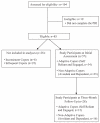Adolescents' pain coping profiles: expectations for treatment, functional outcomes and adherence to psychological treatment recommendations
- PMID: 21766070
- PMCID: PMC3198106
- DOI: 10.1155/2011/652853
Adolescents' pain coping profiles: expectations for treatment, functional outcomes and adherence to psychological treatment recommendations
Abstract
Objectives: To explore how adolescents' pain coping profiles relate to their expectations regarding psychological treatment recommendations, and to examine patients' functioning and engagement in psychological treatment three months following a multidisciplinary pain clinic evaluation.
Methods: Adolescents and their parents completed measures of pain coping strategies, treatment expectations, pain ratings, somatic symptoms, school absences and functional disability. Parents also reported whether patients followed through with psychological treatment recommendations.
Results: Adaptive copers and their parents were more likely to expect psychological treatments to be helpful; however, at follow-up, there were no significant group differences in patients' participation in psychological treatment. Patients in both groups experienced significantly lower levels of somatic symptoms and functional disability, and had fewer school absences from the initial evaluation to the follow-up.
Discussion: The results of the present study identify preliminary clinical implications for the way in which practitioners in multidisciplinary pain clinics present recommendations for psychological treatment to patients and their families.
OBJECTIFS :: Explorer de quelle manière les profils d’adaptation des adolescents à la douleur sont liés à leurs attentes au sujet des recommandations de subir un traitement psychologique et examiner le fonctionnement et l’engagement du patient dans le cadre du traitement psychologique trois mois après une évaluation en clinique multidisciplinaire de la douleur.
MÉTHODOLOGIES :: Les adolescents et leurs parents ont consigné des mesures de stratégies d’adaptation à la douleur, d’attentes envers les traitements, de classement de la douleur, de symptômes somatiques, d’absences scolaires et d’incapacité fonctionnelle. Les parents ont également indiqué si les patients respectaient les recommandations de subir un traitement psychologique.
RÉSULTATS :: Les jeunes qui s’adaptaient bien et leurs parents étaient plus susceptibles de s’attendre que les traitements psychologiques soient utiles, mais au suivi, on ne remarquait pas de différences significatives entre les groupes pour ce qui est de la participation des patients à ce traitement. Les patients des deux groupes ont présenté des taux de symptômes somatiques et d’incapacité fonctionnelle beaucoup plus faibles et des absences scolaires moins nombreuses entre l’évaluation initiale et le suivi.
EXPOSÉ :: Les résultats de la présente étude indiquent les conséquences cliniques préliminaires de la manière dont les praticiens des cliniques multidisciplinaires de la douleur présentent les recommandations de subir un traitement psychologique aux patients et à leur famille.
Figures
Similar articles
-
Treatment expectations among adolescents with chronic musculoskeletal pain and their parents before an initial pain clinic evaluation.Clin J Pain. 2014 Jan;30(1):17-26. doi: 10.1097/AJP.0b013e3182851735. Clin J Pain. 2014. PMID: 23446075 Free PMC article. Clinical Trial.
-
Engagement in multidisciplinary interventions for pediatric chronic pain: parental expectations, barriers, and child outcomes.Clin J Pain. 2010 May;26(4):291-9. doi: 10.1097/AJP.0b013e3181cf59fb. Clin J Pain. 2010. PMID: 20393263
-
Chronic pain in adolescence: parental responses, adolescent coping, and their impact on adolescent's pain behaviors.J Pediatr Psychol. 2008 Sep;33(8):894-904. doi: 10.1093/jpepsy/jsn029. Epub 2008 Mar 28. J Pediatr Psychol. 2008. PMID: 18375447 Free PMC article.
-
Toward the development of a motivational model of pain self-management.J Pain. 2003 Nov;4(9):477-92. doi: 10.1016/s1526-5900(03)00779-x. J Pain. 2003. PMID: 14636816 Review.
-
Coping strategies in chronic pain.Curr Pain Headache Rep. 2010 Oct;14(5):331-8. doi: 10.1007/s11916-010-0137-3. Curr Pain Headache Rep. 2010. PMID: 20680705 Review.
Cited by
-
Treatment expectations among adolescents with chronic musculoskeletal pain and their parents before an initial pain clinic evaluation.Clin J Pain. 2014 Jan;30(1):17-26. doi: 10.1097/AJP.0b013e3182851735. Clin J Pain. 2014. PMID: 23446075 Free PMC article. Clinical Trial.
-
The ripple effect: systems-level interventions to ameliorate pediatric pain.Pain Manag. 2012 Nov;2(6):593-601. doi: 10.2217/pmt.12.63. Pain Manag. 2012. PMID: 23544034 Free PMC article.
-
How adolescents experience and cope with pain in daily life: a qualitative study on ways to cope and the use of over-the-counter analgesics.BMJ Open. 2016 Mar 1;6(3):e010184. doi: 10.1136/bmjopen-2015-010184. BMJ Open. 2016. PMID: 26932141 Free PMC article.
-
Validation and clinical application of a biopsychosocial model of pain intensity and functional disability in patients with a pediatric chronic pain condition referred to a subspecialty clinic.Pain Res Treat. 2013;2013:143292. doi: 10.1155/2013/143292. Epub 2013 Oct 22. Pain Res Treat. 2013. PMID: 24251035 Free PMC article.
-
Adolescent pain catastrophizing mediates the relationship between protective parental responses to pain and disability over time.J Pediatr Psychol. 2013 Jun;38(5):541-50. doi: 10.1093/jpepsy/jst011. Epub 2013 Mar 7. J Pediatr Psychol. 2013. PMID: 23471361 Free PMC article.
References
-
- Walker LS, Smith CA, Garber J, et al. Development and validation of the Pain Response Inventory for children. Psychol Assess. 1997;9:392–405.
-
- Kaminsky L, Robertson M, Dewey D. Psychological correlates of depression in children with recurrent abdominal pain. J Ped Psychol. 2006;31:956–66. - PubMed
-
- Sullivan MJL, Thorn B, Haythornthwaite JA, et al. Theoretical perspective on the relation between catastrophizing and pain. Clin J Pain. 2001;17:52–64. - PubMed
MeSH terms
LinkOut - more resources
Full Text Sources
Medical


